 |
From the Director: Fortuitous outcomes on two fronts for Jefferson Lab
|
 |
Using Generalized Parton Distributions: Research collaboration seeks 3-dimensional image of the proton
|
 |
Jefferson Science Associates, LLC announces formation of committee to search for next Jefferson Lab Director; posts search announcement
|
 |
Annual JLab Property Inventory gets underway. Is all of your JLab property, equipment and materials accounted for?
|
 |
Two-factor authentication to enhance Jefferson Lab cyber security
|
 |
In Their Own Words - with Todd Kujawa, JLab's Electrical Safety Engineer
|
 |
Seven Jefferson Science Associates fellowships awarded for research at Jefferson Lab
|
 |
Grafton machine shop wins Jefferson Lab's annual small business award for fiscal year 2006
|
 |
Jefferson Lab awards contract for next cluster computer, which will triple Lab's high-end computing capabilities
|
 |
JLab welcomes JLWS Enterprises as new mentor-protégé vendor
|
 |
Ready, Set, Go! JLab's annual Run-A-Round is set for Wednesday, May 30
|
 |
Information Resources recently announced the availability of two new services available for Jefferson Lab staff and active Users.
|
 |
Milestones: late March through early May 2007
|
 |
In Memoriam: JLab mourns recent deaths within JLab community |
From the Director: Fortuitous outcomes on two fronts for Jefferson Lab (top ^)
Christoph W. Leemann, Director
It is always a great pleasure to communicate good news and report on successes, achievements, and fortuitous outcomes, and last week presented the Lab with two such occasions. The first relates to further consolidation and positioning of the Lab's 12 GeV Upgrade and the second holds great promise for improvements in the Lab's infrastructure.
Every five to six years, the Nuclear Science Advisory Committee, a body of eminent representatives of the field commissioned to advise both the Department of Energy and the National Science Foundation, is charged with producing a Long Range Plan, a roadmap outlining the nuclear science research community's consensus on priorities and funding opportunities. The recommendations of the LRP, based upon a lengthy and thorough process involving the entire nuclear science community, carry great weight and strongly influence funding agencies' resource allocations.
The last LRP, published in 2002, listed the 12 GeV Upgrade as the fourth of four recommendations. Last week the resolution meeting for the 2007 LRP took place with Tony Thomas, Larry Cardman, Rolf Ent, and Lia Merminga representing the Lab. This time, completion of the 12 GeV Upgrade was the first of four recommendations. This good outcome further consolidates the scientific priority of the 12 GeV Upgrade, encourages appropriate funding by the DOE, and of course, commits the Lab to put every effort possible behind an on-cost, on-schedule, and technically, fully successful execution of the project.
The second bit of positive news will benefit many of you who work at some of our older facilities. As you are aware, some of these facilities are not quite as "world-class" as we would like them to be. Space to stage major experiments is scarce, assembly of our high-tech superconducting radiofrequency components takes place in a nearly 40-year-old building, and some of you work in service buildings restructured as work places. At the request of the DOE, Mike Dallas, Rusty Sprouse and many others prepared a Lab proposal for a competitive, system wide infrastructure modernization initiative covering all Office of Science laboratories.
Competing in this setting is tough, because many of the older laboratories have even more serious space and building issues. The team went through several iterations of proposals, participated in two meetings with representatives of the DOE and all the other labs, refining, prioritizing, and winnowing the proposal. Last week we learned that the DOE has included the Lab's proposal in its plans for FY2009 through 2012 at a cost of over $63.5 million. The project combines rehabilitation of the Test Lab with the creation of an engineering and technical support complex that will provide collocation of engineers and technicians in a modern, conveniently located facility. I am very happy and proud that the Lab finally can make progress in closing an important gap and provide top-notch working locations to everybody on site.
Christoph Leemann
Using Generalized Parton Distributions: Research collaboration seeks 3-dimensional image of the proton (top ^)
A computed tomography - CT - scan can help physicians pinpoint minute cancer tumors, diagnose tiny broken bones and spot the early signs of osteoporosis. Now physicists are using the principles behind the procedure to peer at the inner workings of the proton. In a recent experiment, members of Jefferson Lab's Deeply Virtual Compton Scattering (DVCS) collaboration found that it will be possible to construct three-dimensional images of the building blocks of the proton.
GPDs are a set of mathematical functions that describe the spatial-distribution inside the proton of quark and gluon waves.
For more information, visit these links:
In 1895, German Physicist Wilhelm Röntgen was working in his laboratory when he noticed that a nearby screen was glowing. The glowing screen was Röntgen's first glimpse of the effects of x-rays, a discovery that later won him the inaugural Nobel Prize in Physics in 1901. Seventy years later, researchers tested the first prototype computed tomography, or CT, system. CT systems acquire two-dimensional x-ray images and combine them into three-dimensional pictures, allowing doctors to see cancer tumors, bone fractures and osteoporosis.
Now, physicists are benefiting from the radical idea that transformed flat x-ray films into 3-D pictures of the inside of the human body. They're testing whether it's possible to measure a series of 2-D images of the interior of a proton and then combine them into a single, 3-D image.
The research is made possible by a relatively new concept in nuclear physics called Generalized Parton Distributions (GPDs). GPDs are mathematical functions that may one day allow physicists to map out the location and momentum of the building blocks of the proton - quarks and gluons - to provide an essentially holographic picture of the proton's inner structure.
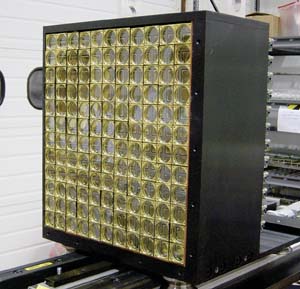
This deeply virtual Compton scattering calorimeter was assembled at Jefferson Lab. The lead-fluorite crystals look like glass, but they're very dense - basically as heavy as iron. The calorimeter contains 132 rectangular crystal rods, each measuring 3 cm by 3 cm on end and nearly 20 cm in length. Attached to the end of each crystal is a photomutiplier tube. Photo credit: DVCS Collaboration
The first dedicated experiment to explore whether nuclear experiments could provide enough information to plug into GPDs for obtaining that 3-D picture of the proton was performed in Jefferson Lab's Experimental Hall A in late 2004. Physicists sent a beam of electrons into a liquid hydrogen target. The researchers were interested in those collisions where a high-energy electron strikes an individual quark inside the proton, giving the quark an extremely large amount of extra energy. This quark then quickly gets rid of the excess energy by emitting a high-energy photon, or particle of light. The whole process takes place without breaking the proton apart. This effect is called deeply virtual Compton scattering (DVCS).
To obtain the new result, researchers needed to measure the energy and angle of scattering of the electron that bounced off the quark and the energy and emission angle of the photon given off by the quark. The researchers used one of Hall A's High Resolution Electron Spectrometers to measure the electron, and the photon was measured by a unique detector built specifically for this experiment, the DVCS calorimeter.
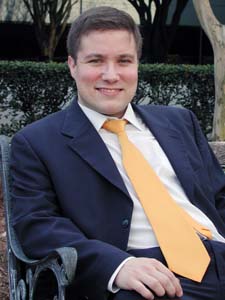
Carlos Muñoz Camacho, a User from the Department of Energy's Los Alamos National Lab, is a co-spokesperson for two new experiments approved for Hall A - an experiment at 6 GeV in preparation for the 12 GeV Upgrade and a GPD (Generalized Parton Distributions) experiment to run once the Upgrade is in place. Visit JLab's website for more scientific information about deeply virtual Compton scattering research conducted at JLab.
The researchers found that this type of experiment is, indeed, capable of collecting enough information in the future to be used in GPDs for generating a 3-D map of the internal structure of the proton. "This is the most important result of the experiment, because it means that we can use the information from the photon we detect in order to gather information from the quark that emitted that photon. Strictly speaking, it means that we can access Generalized Parton Distributions (GPDs) from DVCS," says Carlos Muñoz Camacho, a User from the Department of Energy's Los Alamos National Lab and lead author on the recent paper in Physical Review Letters.
Thanks to the positive result, Muñoz Camacho sees a future for DVCS research at Jefferson Lab. "The GPD program is at the heart of the scientific motivation for the Jefferson Lab upgrade. A new experiment at 6 GeV in preparation for the 12 GeV Upgrade was approved with the highest scientific rating (A), and a GPD 12-GeV experimental program in Hall A was approved last year," he notes. Muñoz Camacho is a co-spokesperson for both experiments.
As with any major experiment, a number of institutions contributed the people, expertise, funding and equipment that made this experiment possible, including Jefferson Lab, French CEA/DSM/DAPNIA & CNRS/IN2P3, Old Dominion University and Rutgers University. The co-spokespersons of the Hall A proton DVCS experiment are Pierre Bertin (Clermont-Ferrand and JLab), Charles Hyde-Wright (Old Dominion University), Ron Ransome (Rutgers University), and Franck Sabatié (CEA-Saclay). The experimental effort also benefited from a close relationship with JLab theorists Anatoly Radyushkin (ODU) and Marc Vanderhaeghen (William and Mary).
Jefferson Science Associates, LLC announces formation of committee to search for next Jefferson Lab Director (top ^)
The Board of Directors Chair for Jefferson Science Associates announced on April 19, 2007, the appointment of the Jefferson Lab Director Search Committee. John T. Casteen, President of the University of Virginia, disclosed the list of 14 committee members, which had their first organizational meeting in Washington, D.C., on April 27. Thomas Appelquist, a physics professor at Yale University, is chairing the committee.
"I am especially pleased with the level of experience and commitment to quality science represented on this Committee," Casteen said. "With the critical scientific mission of the Lab at the dawn of a major upgrade - doubling the Lab's energy and research capacity - I trust this Committee's judgment in helping us find the distinguished and energetic leadership that this job demands."
The committee includes:
- Thomas Appelquist, Ph.D., Chair, (Professor of Physics, Yale University & JSA Board of Directors)
- Ernest J. Moniz, Ph.D., Deputy Chair, (former Undersecretary, Department of Energy & JSA Board of Directors)
- O. Keith Baker, Ph.D. (Professor of Physics, Yale University)
- Jerry P. Draayer. Ph.D. (President & CEO, SURA & JSA Board of Directors)
- Rolf Ent, Ph.D. (12 GeV Science Lead and former Hall C Leader, Jefferson Lab)
- Bernard Frois, Ph.D. (Director of Research, National Center for Scientific Research, France)
- Gerry Garvey Ph.D. (experimental nuclear physicist and a Senior Fellow at Los Alamos National Laboratory.)
- Don Geesaman, Ph.D. (a Senior Physicist and the Associate Director of the Physics Division at Argonne National Laboratory)
- John A. Gordon, Gen., USAF, Ret. (former Administrator, National Nuclear Security Administration & JSA Board)
- Lawrence H. Hare, Ph.D. (President, CSC Applied Technology Division & JSA Board of Directors)
- Walter F. Henning, Ph.D. (Director of GSI, Darmstadt, Germany)
- Emlyn Hughes, Ph.D. (Professor of Physics, Columbia University)
- Allison Lung, Ph.D. (12 GeV Upgrade Deputy Project Manager, Jefferson Lab)
- Steve J. Wallace, Ph.D. (Professor of Physics, University of Maryland & JSA Board of Directors)
The Committee's task is to recommend a replacement for Christoph Leemann, who announced on March 15 that he is stepping down as director - a position he has held for six and a half years. The position also serves as the President of Jefferson Science Associates, a joint venture between the Southeastern Universities Research Association (SURA) and CSC Applied Technologies, which was awarded the Thomas Jefferson National Accelerator Facility (Jefferson Lab) management and operating (M&O) contract from the U.S. Department of Energy (DOE) in a recompetition during spring 2006.
Jefferson Lab is a renowned research facility with more than 1,200 international users. Nearly one-third of the Ph.D.'s awarded in nuclear physics in the U.S. result from research done at Jefferson Lab. And over 90 new faculty positions in the nuclear physics discipline have been added in universities throughout the southeastern region of the country since SURA was awarded the original DOE contract for Jefferson Lab.
Annual JLab Property Inventory gets underway. Is all of your JLab property, equipment and materials accounted for? (top ^)
"The annual Property Validation by each JLab Property Custodian is complete. We are ready to start the next step - the annual Property Inventory," says Tom Briggs, JLab Property Manager.
The annual validation process began in February. "Validation" required each Property Custodian - anyone with JLab property, equipment or materials assigned to them - to confirm specific information regarding each item assigned to them.
Next comes the annual Property Inventory, which is required by the Department of Energy. "Twenty percent of all JLab Property Custodians will be randomly selected to participate in the inventory," Briggs explains. "That means all of the items assigned to each of the 120 randomly selected custodians will be inventoried."
While the selected Property Custodians will be notified that their accounts are among those randomly chosen for the inventory, a Property Management representative will carry out the inventory process independently of the custodians. Using the Property Custodians' validated records; the inventory specialists will go to the indicated locations to verify each item. The inventory team members will carry laser barcode readers to allow them to scan the JLab Property Tag of each item in the Property Custodian's account.
How can Property Custodians help this process? Keep your account updated, Briggs says. If you move an item, update your property account. Indicate the new location in the property system. If you have an item for disposal, contact the Property Management office (ext. 6270 or 7348) to make appropriate arrangements. If a Property Custodian can't locate an item, Briggs encourages them to regularly check their property account. Briggs notes, "Many times, items have been moved unbeknownst to the Property Custodian and someone from my team will scan it in the course of inventorying a building. The location where it was most recently 'scanned' will be added to the database and appear in the custodian's account."
Briggs anticipates the inventory taking a couple months to complete. Results of the inventory are reported to DOE.
Two-factor authentication to enhance Jefferson Lab cyber security (top ^)
Logging in to Jefferson Lab computers is becoming more secure, thanks to the efforts of JLab's tireless Computing and Networking Infrastructure (CNI) group in the Information Technology Division.
With a valid username and the associated password, anyone can break into Jefferson Lab's computer network. Now the CNI group is aiming to make Jefferson Lab's network a bit tougher to crack into.
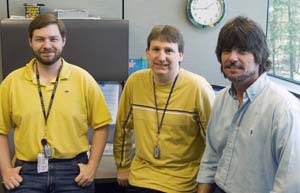
Paul Letta (center), Unix Systems Manager in the Information Technology Division's Computing and Networking Infrastructure (CNI) group and co-workers Ethan O'Toole (left) and Marty Wise are working to improve JLab's cyber security.
Jefferson Lab is moving to improve the security of computers, networks, PII (personally identifiable information), and business sensitive information. Paul Letta, Unix Systems Manager in the CNI group, says one way the Lab is improving network security is by implementing a more robust computer user authentication system.
"In regular authentication, you have just one known password that you need to input. But passwords get sniffed and are stolen all the time," Letta says. "The Department of Energy's Office of Science has sent hacker teams to the Lab to test our systems twice over the last few years. Both times, stolen passwords were used to hack our network."
He further points out that over the last two years, most of the cyber security intrusions into Jefferson Lab's networks were the result of stolen passwords. To remedy that, the CNI group will be moving the Lab to a strong authentication system. "We're going to two-factor authentication, which is a much more secure method. It requires two of the following things: something you know, something you have, or something you are," Letta explains.
For instance, authentication could require that you know a user name and password that you input, just like the system now in place for most Jefferson Lab staff and Users. Plus, authentication could also require something that you have - such as a card that must be inserted into a card reader or a token that provides an additional password. It could also require a user (a JLab computer account holder) to identify them self with something they are, known as biometrics. In this example, a user would be required to provide a thumb print or a retinal scan to prove identity.
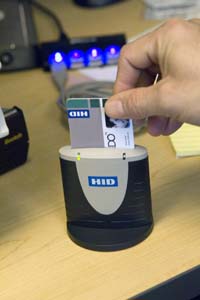
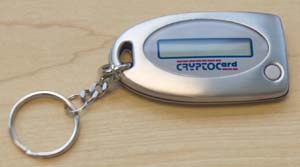
A smart card and reader (left): The company that manufactures JLab's badges also makes smart cards. The CNI group is exploring the possibility of integrating the two into one badge that could be used to access work areas and as one piece of the authentication needed for accessing computer systems. Above is an example of a CryptoCard token. JLab computer account holders might use this token to log in to JLab machines while outside the JLab network.
The CNI group is deploying a system that requires two-factor authentication: something a user knows and something they have. In this case, the user will need to know a personal identification number (PIN) consisting of four to eight digits and, in some cases, a username. The user would also need to have one of two other things: a CryptoCard token or a smart card.
Users issued a smart card will simply insert the card into a card reader plugged into a USB jack on the computer. The user's PIN unlocks the card, which has a chip that automatically authenticates the user's identity at login through a special server located on JLab's network.
Users issued a token will push a button on the token to obtain a six-digit code good for just one login, called a one-time password. The one-time password is then added to the user's PIN to form the user's full password. This password is also authenticated by the CryptoCard server at login. The server and the token use the same algorithm to generate/authenticate the one-time passwords, and the server recognizes the next several passwords that may be used, in case the user accidentally presses the button on the token a few times before using a one-time password.
Both of these systems will increase the security of JLab's network. "So a hacker won't be able to break into JLab's network simply by stealing a username and password anymore," Letta says. "Today, all of the network equipment, CNI and MIS servers and desktops are protected by this. In the near future, all of Business Services and people who have access to PII (personally identifiable information) will also have two-factor authentication in place," Letta says. Depending on the success of the two-factor system, other groups at and affiliated with the Lab, including the Lab's scientific Users, may be integrated into the two-factor authentication system.
In Their Own Words - with Todd Kujawa, JLab's Electrical Safety Engineer (top ^)
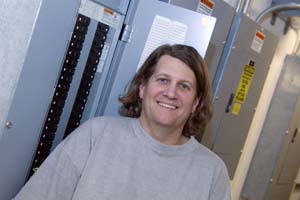
Todd Kujawa (pronounced Kwee-ahvah) works a range of JLab electrical safety topics, including: — Developing, presenting and updating JLab electrical training materials. — Involved with the continuation of the Energy Load Control Program within the Accelerator Division. — Ensuring that JLab is compliant with the National Electrical Code (NEC), NFPA 70E (National Fire Protection Association), OSHA (Occupational Safety and Health Administration), and Department of Energy (DOE) Orders concerning electrical safety.
Todd maintains an open door policy for anyone at JLab with an electrical support issue or safety concern. He is always available to provide guidance on understanding/following safety procedures, providing oversight for equipment setup/installation, reviewing work control documents, and being that extra set of eyes or hands on electrical jobs.
Todd has recently been working on Arc Flash Hazards. "Arc Flash Hazards can happen anywhere and at anytime," he points out. "It doesn't just happen to others, it can happen to you. Wearing the correct personal protective equipment (PPE) and following procedures will help you to defend against this [electrical] explosive behavior known as an Arc Flash."
I'm originally from upstate New York, just outside Buffalo, where I went to public schools and then to Niagara County Community College. I earned an associate's degree in electrical engineering technology there and started working right away for area electrical contractors doing residential and commercial wiring installations.
In 1992, I came to Virginia Beach to visit a friend from home that had moved here. I only came for a long weekend, but I met a really special girl at a party and stayed for an extra day. I was so smitten with her that I went back home, packed my things and moved to the Beach a week later. Cherie and I were married in June 1994.
I had landed a job with the Southeastern Virginia Public Service Authority (SPSA) at their plant in Portsmouth, where I was doing industrial electrical maintenance on second shift, while I continued to do other electrical work during the day. I stayed at SPSA several years, but realized pretty quickly that I'm not a second-shift kind of guy.
From there I was hired by a government contracting company based in Maryland, and started working on projects for the Navy, installing firefighting training modules. It started out as a temporary position, but then I was hired permanently. During my four years with the company, I had the opportunity to travel for extended periods to Florida, Texas, Illinois and Maryland. Since we had no children at the time, my wife was able to come with me and we really had a great time seeing different parts of the country.
Ultimately, we moved to Chesapeake and I went back to school at Old Dominion University. It was challenging and interesting, since I was a much older student than my classmates. I think it was good for me to do it that way, though, because I was old enough to be able to focus on my schoolwork. And since I was paying for it myself, I knew I needed to get that degree work finished and get back to working for a living. I graduated in 2001, when I was 35, with a bachelor's in electrical engineering. Over the years, I've also earned my license as a Master Electrician and am currently an Engineer in Training, working toward being licensed as a Professional Engineer.
I spent the following five years working for the Naval Facilities Engineering Command, doing electrical designs and managing construction for shore facilities such as hospitals and dormitories. We had moved to Hampton by then, and my job increasingly involved doing more routine paperwork rather than designing. Plus, I had the tunnel to contend with twice a day. I started looking for positions on the Peninsula.
My friend Chris Behre was working here at the FEL (Free-Electron Laser) and he mentioned an opening for an electrical engineer in the Environmental, Safety, Health and Quality Division. I was lucky enough to get the job and started working here in early October 2006.
In my position at the Lab, I review electrical safety policies, implement new policies, and oversee work by Lab employees and outside contractors. I also chair the Electrical Safety Committee. One of the best things about working here has been not only how helpful everyone has been to me as a newcomer, but also how much of a collaborative environment it is. Safety is a critically important issue Lab-wide, and everybody has an involvement and concern with it.
My wife works for the federal courts in Newport News. We have two daughters, and our leisure time is spent doing family things. We live near the beach in Buckroe.
Jefferson Science Associates, LLC, announces seven fellowship awards for research at Jefferson Lab (top ^)
The Southeastern Universities Research Association recently announced the award of seven Jefferson Science Associates, LLC, fellowships for research related to the physics programs at Jefferson Lab. The 2007-08 academic year recipients, who are graduate students from SURA (Southeastern Universities Research Association) member universities, are:
Nathan Baillie and Joseph Katich, College of William and Mary
Panying Chen, University of Maryland
Chiranjib Dutta, University of Kentucky
Edwin Munevar, The George Washington University
Andrew Puckett, Massachusetts Institute of Technology
Jixie Zhang, Old Dominion University
"SURA is proud to assist with these fellowships which are an important investment in future scientists," said Jerry P. Draayer, President and CEO of SURA. "Furthermore, they provide an excellent opportunity to grow the research capacity of SURA schools through the association of these students and their faculty mentors with a world-class research laboratory."
The awardees were recommended by a Fellowship Selection Committee chaired by Thomas Clegg, a professor at the University of North Carolina-Chapel Hill and long-time, former SURA trustee. Other members are Gordon Cates of the University of Virginia, Chair of the Jefferson Lab User Group Board; Gerard Gilfolye, University of Richmond; Richard Haglund, Vanderbilt University; and Robert Welsh of the College of William and Mary and Head of the Jefferson Lab Office of Student Affairs.
In his letter of award recommendation to Draayer, Professor Clegg noted, "[C]ommittee members agreed that the overall quality of the candidates selected for these fellowships remains high, which speaks well of the continued attractiveness of both JLab and of its physics."
The fellowship award amount is equal to one half the nine month stipend of a research assistant at the applicant's home university (the university must pay the other half) plus $2,000 and a travel allowance of an additional $2,000. The average total award for 2007 is over $12,000.
These fellowships were initiated by SURA in 1989 to assist in increasing the opportunities for graduate study at Jefferson Lab and to enhance the research capabilities of outstanding students at SURA member universities. Jefferson Science Associates (JSA) - of which SURA is majority partner - was created in 2006 to compete for, and now serve as, the new management and operating contractor for JLab. The fellowship program has been continued under the aegis of the JSA.
Through 2007, a total of 133 fellowship awards have been made to students at 18 SURA member universities.
(Information courtesy of SURA press release.)
Grafton machine shop wins Jefferson Lab's annual small business award for fiscal year 2006 (top ^)
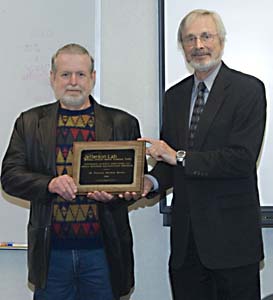
Jim Rohrbach, owner of J.R. Precision Machine Service, of Grafton, was recently recognized as the Jefferson Science Associates/Jefferson Lab Outstanding Small Business Subcontractor for Fiscal Year 2006. Here he receives a plaque from JLab Director Christoph Leemann. Rohrbach was commended for being consistently responsive and providing quality products to the Lab.
J.R. Precision Machine Service, of Grafton, Virginia, was recently recognized as the Jefferson Science Associates/Jefferson Lab Outstanding Small Business Subcontractor for Fiscal Year 2006. At a reception held during March at Jefferson Lab, Department of Energy officials, senior JLab management, procurement and technical staff gathered to congratulate business owner Jim Rohrbach as he received the award from JLab Director, Christoph Leemann. Rohrbach's company was commended for being "consistently responsive and providing quality products to this laboratory."
"Your work in providing top-notch fabricated machine parts... is especially noteworthy and has certainly contributed to the lab's success in meeting our mission objectives," Leemann wrote in a congratulatory letter to Rohrbach.
Jim Rohrbach, owner of J.R. Precision Machine Service, has provided excellent service to the Lab for more than 13 years, according to Danny Lloyd, JLab Purchasing and Small Business Program Manager. "He provides high-precision fabrication and machining services for multiple work groups at Jefferson Lab. Over the years he has successfully completed more than 90 workorders, many with exacting specifications and on tight delivery deadlines. Jim has repeatedly earned praise for the work he's done for the Lab."
"The competition for this award is tough," Lloyd pointed out. "Jefferson Lab subcontracts a broad range of supplies and services and J.R. Precision Machine Service was one of hundreds of small business firms that did business with JLab during FY2006." Any small business, small woman-owned, veteran-owned, service-disabled/veteran-owned, or HUBZone small business or disadvantaged business may be considered for the award.
The purpose of the award is to demonstrate JSA/Jefferson Lab's commitment to its small business program, to recognize exceptional performance by a small business on an annual basis, and to provide a visible incentive for small businesses to excel in their performance for Jefferson Lab. Nearly 70 small businesses were initially considered for this year's award. Selection criteria include: customer service response, the percentage of on-time deliveries or quality of services provided, and the magnitude and complexity of the procurements.
"Jim provides services for Fabrication Planning in Accelerator Engineering, the JLab Machine Shop and the Physics Division Target Group. Jim is the go-to guy for jobs requiring special attention to detail. And although he does not have the advantage of many employees, he comes through consistently with tight delivery schedules on difficult parts. Whenever a part has to meet exacting tolerances and finish requirements and cannot be done in house, Jim is the vendor requested by my customers," notes Larry Munk, Engineering Division.
"Since 1995, J.R. Precision has been extremely important to the end result of many of the targets installed in Jefferson Lab's three end stations. Jim has always gone the extra mile for the end result. He is a top notch person that happens to be an excellent machinist," adds Mark Hoegerl, Experimental Nuclear Physics.
Jefferson Lab awards contract for next cluster computer, which will triple Lab's high-end computing capabilities (top ^)
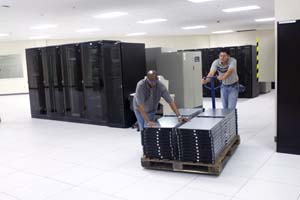
Components from Koi Computing - for JLab's next major cluster computer installation - began arriving in April. The result will be a powerful cluster computer built from off-the-shelf components that will rival the computing power of a supercomputer.
During February, Jefferson Lab awarded a new contract for providing the components of its next major cluster computer installation to Koi Computers, a woman-owned, certified Small Disadvantaged Business located in Lombard, Ill. Koi won the $1.1 million contract with its bid to provide 432 dual processor, dual core computer nodes, with several interesting upgrade options.
Each node, which can be thought of as a single computer, will contain two Advanced Micro Devices (AMD) dual-core processors with 4 Gigabytes (GB) of onboard random access memory (RAM). The nodes will be connected via a Double Data Rate Infiniband network, which is capable of transferring 20 Gigabits of data per second (Gb/s) between the nodes.
The result will be a powerful cluster computer built from off-the-shelf components that will rival the computing power of a supercomputer. The cluster, dubbed 7N, will be installed in Jefferson Lab's recently expanded Computer Center. Portions of the system began arriving in April and are being installed. Once in place, the new cluster will more than triple the Lab's high-end computing capabilities.
Fanny Ho, the CEO of Koi Computers, says she is happy her company won the contract and is looking forward to fulfilling the order. "It's very important to us, especially since we are such a small business."
"They beat out other bidders by a strategy of offering a very good product, aggressively priced and a strategy for upgrading," says Roy Whitney, Jefferson Lab Chief Information Officer. "They have a proven track record of being able to deliver, and we are very excited to work with them."
In the meantime, Jefferson Lab will be evaluating AMD's quad-core chips, which may later be used to upgrade the cluster's total computing capability. The additional processors would also be provided by Koi Computers.
This cluster will triple the theory-computing capacity at the Lab, and will support the work of the national USQCD (quantum chromodynamics) collaboration, including Nuclear Physics and High Energy Physics researchers, according to Chip Watson, Head of JLab's Scientific Computing group, which is part of the Information Technology Division. The new cluster will continue the work of its Jefferson Lab predecessors, running powerful computer simulations to shed light on how one of the basic forces of nature, the strong force, builds protons, neutrons and other particles out of the basic building blocks of matter, quarks and gluons.
For more information on Jefferson Lab's cluster computing efforts, visit: https://www.jlab.org/news/releases/supercomputing-shoestring-cluster-computers-jlab
JLab welcomes JLWS Enterprises as new mentor-protégé vendor (top ^)
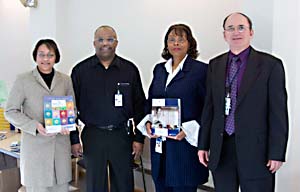
JLWS Enterprises, Inc., President Kevin Watson handed out his product catalogue and familiarized JLab staff with his company's capabilities during a recent lunch-time visit. Here he is flanked by Corporate Express partner Veronica Thomas (left), Reneé Carter (right), JLab Procurement Administrator and Danny L. Lloyd, JLab Small Business Program Manager.
Early in March, JLWS Enterprises, Inc., a small, disadvantaged, veteran-owned business became Jefferson Lab's first mentor-protégé vendor under the new Department of Energy/Jefferson Science Associates, LLC contract, according to Danny L. Lloyd, JLab's Small Business Program Manager.
The DOE mentor-protégé program is designed for DOE prime contractors (like JLab) to mentor and guide woman- and minority-owned businesses - so that they become new small- and disadvantaged-business resources within the Department of Energy and larger government-vendor communities. During the three-year contract JLWS has with Jefferson Lab, the Lab will mentor JLWS and promote the growing company within DOE and to other government contractors. JLWS has been a vendor here for about one year - providing a variety of office products including copier and printer toner cartridges, according to Lloyd. Now, JLWS is JLab's primary supplier for all office supplies, including recycled-product-content office supplies, furniture, recycled toner cartridges and other recycled products.
JLWS President Kevin Watson, a service-disabled veteran, set up an informational table in the CEBAF Center lobby on March 12, to hand out his product catalogue and familiarize JLab staff with his company's capabilities. Extra copies of the JLWS office product solutions catalogue are available for pick up on the file cabinet by the CEBAF Center mail box area between rooms C101 and L107. Orders may be put in through webstock.
Watson cites the benefits of doing business with JLWS as: providing the personalized customer service you expect from a small business with the capabilities and reach of a large business. JLWS partners with companies like Corporate Express to enhance its capabilities and business reach. "This is a win-win arrangement. JLWS has the opportunity to grow and expand and Jefferson Lab gets good service and competitive prices," Watson notes.
The three-year-old business, based in Norfolk, Va., has a contract with NASA, and Danny Lloyd notes that the specialized services JLWS has developed for that customer could be of benefit to JLab as work moves forward on the 12 GeV Upgrade project.
Ready, Set, Go! JLab's annual Run-A-Round is set for Wednesday, May 30 (top ^)
At a Glance
- Register Online: Now through 11 a.m. Wednesday, May 30
- Pick up racing bib (number): Wednesday, May 30, 9 a.m. - 2 p.m. in the CEBAF Center Lobby
- Late registration: 11 a.m. - 2 p.m. in the CEBAF Center Lobby (late registrants not eligible for prizes) Event
- 3 p.m. - Winning T-shirt design announced and designer recognized (CEBAF Center Circle)
- 3:30 p.m. - Run-A-Round begins (Start line on SURA Road in front of CEBAF Center Circle)
- 4 p.m. - Food and beverages on Rattley Road - just beyond the finish line. JLab employees & Users turn in run/walk bib for JLab T-shirt.
- 4:30 p.m. - Overall and age category awards and Most Uniquely Dressed and Best Decorated Stroller awards presented.
Looking for a little fun in the sun? The Jefferson Lab Activities Group (JAG) has scheduled the annual Run-A-Round for Wednesday, May 30. This will be the Lab's 22nd fun run. Begin training now for that record-breaking finish, says JAG Chair J.T. Kelley. As in years' past, the event is open to all Lab employees, family members, Users and subcontractors. Employees and Users who participate may collect a free 2007 JLab T-shirt after the event. The JAG will be selling JLab T-shirts and other JLab-branded merchandise after the fun run.
The event will kick off with the unveiling of the winning 2007 JLab T-shirt design at 3 p.m. in the CEBAF Center Circle, where the winner(s) of the T-shirt design contest will be recognized.
The Run-A-Round will start promptly at 3:30 in front of the CEBAF Center Circle. Kelley said the run/walk will cover the same 1.5-mile course used for last year's event. The Peninsula Track Club will provide official times at the finish line, which will be located on the back side of the CEBAF Center parking lot at the intersection with Rattley Road.
Refreshments and awards will follow - on Rattley Road - beyond the finish line. Refreshments will include submarine sandwiches, chips, fruit and beverages. Awards will be presented to the top three male and female finishers and to the top three male and female finishers in each age category. Awards will also be presented to the Most Uniquely Dressed runner/walker and for the most Creatively Decorated Stroller, according to Kelley. "Just be safe and use good taste," he asks.
Run-A-Round Registration
Online registration for the run/walk is currently underway at: https://www1.jlab.org/ul/apps/jag/runaround/. Online registration will run through 11 a.m. race day (Wednesday, May 30). Late registrations will be accepted from 11 a.m. to 2 p.m. in the CEBAF Center lobby; however, please note that late registrants won't be eligible for awards, Kelley says. All participants will be able to pick up their race bibs/numbers in the CEBAF Center lobby between 9 a.m. and 2 p.m. on race day.
Volunteers Needed in Various Capacities
Betty Beeler is heading up the volunteers needed for this event, Kelley adds. "Volunteers are vital to the success of all JAG events," he notes. "All volunteers who don't get a T-shirt for running/walking will get a free T-shirt for helping, and all jobs are low stress. We couldn't do these events without volunteer support. It is a great way to meet people from outside your work area and to interact with the larger JLab community." Sign up is online at https://www1.jlab.org/ul/apps/volunteer/form.cfm?id=24
Volunteers will be needed to:
- Staff the late registration and bib distribution tables the day of the event,
- Help with water stations, course set up and monitoring and the finish line,
- Help with T-shirt distribution and JAG merchandise sales,
- Help at food and beverage tents,
- Clean up
Road Closures before, during and after the Run-A-Round
Rattley Road will be closed to traffic from the evening of May 29 through about 10 a.m. on May 31 - to accommodate tent set up and tear down for the event. During the run/walk, JLab's main entrance (Onnes Drive), SURA Road, Lawrence Road, Hofstadter Road and the parking lot between the VARC and CEBAF Center (Rutherford Road) will also be closed to traffic.
Information Resources recently announced the availability of two new services available for Jefferson Lab staff and active Users. (top ^)
The two new services are called Web of Science and Endnote, according to Elois Morgan, Information Technology Division. Web of Science is a cutting edge multidisciplinary database known for pioneering citation searching. And Endnote is a personal bibliographic manager that is integrated with JLab's new Web of Science service. Together they are a powerful research tool. To learn more and to access this new service, go to: http://www.jlab.org/ir/wos.html.
Contact Elois Morgan, morgan@jlab.org, ext. 7525, if you have questions or would like additional information.
Milestones: late March through early May 2007 (top ^)
Hello
Connie Adams, Systems Accountant, Office of the Chief Financial Officer
Debra Campbell, Shipping & Receiving Clerk, Facilities Management
Audrey Daly, Technical Writer (casual), ESH&Q Division
Rongli Geng, Deputy Group Leader - Process and Materials Group, Accelerator Operations, Research & Development Division
Dean Golembeski, Public Affairs Manager, Office of the Chief Operating Officer
John Hicks, Delivery Driver, Facilities Management
Michael Merz, Accelerator Operator, Accelerator Division
Robert Miller, Mechanical Engineer, Engineering Division
Cindy Saban, 12 GeV Safety Manager, ESH&Q (Environment, Safety, Health & Quality) Division
Joe Scarcello, Chief Financial Officer and Business Operations Manager, Office of the Chief Financial Officer
Vincent Sulkosky, Hall A Post Doctoral Associate, Experimental Nuclear Physics Division
Richard Williams, Electrical/Architectural Engineer, Facilities Management
Elaine Zuchowicz, Shipping & Receiving Clerk, Facilities Management
Goodbye
Erik Abkemeier, Radiation Control Group Leader, ESH&Q Division
Swapan Chattopadhyay, Associate Director, Accelerator Operations, Research & Development Division
Julie Criswell, User Support Technician, Information Technology Division
Dennis Dobbins, Procurement Administrator, Office of the Chief Operating Officer (Retired)
Dan Dotson, Sr. Radiation Control Technical Associate, ESH&Q Division (Retired)
Anthony Kram, Procurement Administrator, Office of the Chief Operating Officer
Olga Trofimova, Associate Coordinator, Accelerator Operations, Research & Development Division
Linda Ware Dylla, Public Affairs Manager, Office of the Chief Operating Officer
These Milestone entries, listed alphabetically, are actions posted by Human Resources from late March through early May, 2007. Current JLab Career Opportunities are posted at: https://careers.peopleclick.com/careerscp/client_jeffersonlab/external/search.do
In Memoriam: JLab mourns recent deaths within JLab community (top ^)
Jim Kelly, distinguished member of Lab's User community, passed away April 21
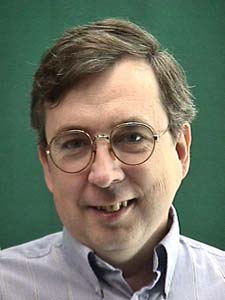
James (Jim) J. Kelly
James (Jim) J. Kelly, a physics professor at the University of Maryland, passed away on Saturday, April 21, 2007, at the age of 52. He was a distinguished member of the JLab user community who made critical contributions to the Hall A Nucleon-Delta Transition experiment and two Hall C GEn experiments. Earlier in his career, Jim was well known for the development of effective interactions in nucleon-nucleus scattering and the determination of neutron transition densities extracted from proton scattering data.
As a teacher, Jim had recently become an expert in the use of Mathematica, particularly in its use in graduate-level physics problems. He developed an online course, Essential Mathematica for Students of Science, which he also taught at the University of Maryland.
In 2006, he published a textbook on Intermediate Methods of Mathematical Physics which includes a CD of Mathematica supplements. Jim was laid to rest on April 25, in Bowie, Maryland, surrounded by family and friends. He is survived by his wife Melinda and daughter Colleen.
Additional information about Jim and his research and classroom work is at: http://www.physics.umd.edu/enp/jjkelly/
Steve Hickson, retired JLab staff member, passed away April 12
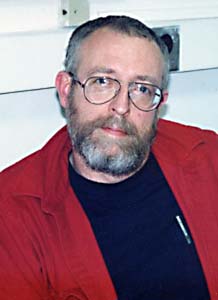
Steve Hickson
Stephen Alan Hickson, 61, died April 12, 2007. His passing was listed in the Obituaries section of the Daily Press on April 15.
He was born in Omaha, Nebraska. He resided in Lansing, Michigan, for many years, where he worked at the Cyclotron Lab at Michigan State University. He moved to Newport News in 1992 and began working for Jefferson Lab. He worked here in a variety of technical capacities until his retirement in 2005.
Steve is survived by his wife, Christine Kling; daughter, Katie Hickson; sister, Susan Reinarz and her husband, Jim of Grand Prairie, Texas; brother, Gary Hickson; nephew and nieces, Matt, Sara and Alexis Reinarz; and his dog, Ginny.
The family requests that expressions of sympathy take the form of contributions to the Peninsula S.P.C.A, 523 J.Clyde Morris Blvd., Newport News, VA 23601. The family held a visitation on April 16 at Berceuse Funeral and Cremation Traditions in Hampton.
Former Free-Electron Laser Department Head Courtlandt Bohn died in early April
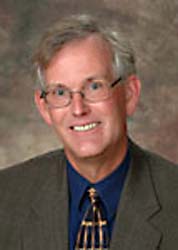
Court Bohn
Court Bohn passed away on April 1 after a difficult battle with cancer. Court served as Deputy Head of the FEL Department (1995-1999), leading design and construction of the recirculating accelerator for the Free-Electron Laser and commissioning of the completed machine. He made many friends during his tenure at JLab. A visitation was held at the Butala Funeral Home in Sycamore, IL on April 4. A memorial service was held at Northern Illinois University's Altgeld Hall Auditorium on April 5. For additional information, visit: http://www.nicadd.niu.edu/~clbohn/

